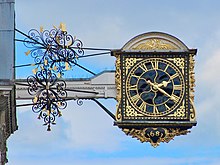
Guildford Guildhall

| Guildford Guildhall | |
|---|---|
 | |
| Type | Guildhall |
| Location | High Street, Guildford, Surrey |
| Coordinates | 51°14′09″N 0°34′20″W / 51.23587°N 0.57236°W |
| OS grid reference | SU 99764 49492 |
| Built | c. 1550 |
| Architectural style(s) | Elizabethan |
| Owner | Guildford Borough Council |
Listed Building – Grade I | |
| Official name | The Guildhall, Guildford |
| Designated | 1 May 1953 |
| Reference no. | 1180101 |
The Guildford Guildhall is a Guildhall located on the High Street of the town of Guildford, Surrey. It is a Grade I listed building.[1]

History


The Guildhall, which initially accommodated a market hall on the ground floor and a courtroom on the first floor, was built around 1550.[1] It was substantially remodelled with a new facade and a new council chamber being installed on the first floor in 1683.[2][3] The external design involved three doors on the ground floor, three mullion windows flanked by Ionic order pilasters augmented by a balcony with iron railings on the first floor and an ornamental cupola on the roof.[1] The projecting clock, erected at that time, was presented to the council by a London clockmaker, John Aylward, in return for being allowed to trade in the borough.[2][4]

The interior design involved a courtroom on the ground floor and a council chamber on the first floor.[3] The panelling in the council chamber was taken from Stoughton Manor House shortly before it was demolished in the late 17th century.[2] The ornamental cupola was replaced in 1882.[1]

During much of the 20th century the town hall served as the meeting place of the Municipal Borough of Guildford but it ceased to be the local seat of government in 1974, when the amalgamation of the municipal borough of Guildford and Guildford Rural District to form Guildford Borough Council took place; the amalgamated Borough Council decided to hold its meetings at Millmead House.[5]

Art collection
Works of art in the Guildhall include a portrait of King James VI and I by Paul van Somer I,[6] a portrait of King Charles II by Peter Lely[7] and a portrait of King James II, also by Peter Lely.[8] There are also paintings of King William III and Queen Mary II by John Riley[9][10] and a painting depicting Vice-Admiral Sir Richard Onslow receiving the surrender of the Dutch flag after the Battle of Camperdown on 11 October 1797 by John Russell.[11]

Present
Guided tours of the Guildhall are conducted bi-weekly. The Guildhall is also available for private hire.[12]

See also
References
- ^ a b c d Historic England. "The Guildhall (1180101)". National Heritage List for England. Retrieved 7 November 2014.
- ^ a b c "History of the Guildhall". Guildford Borough Council. Retrieved 4 October 2018.
- ^ a b Malden, H E (1911). "'The borough of Guildford: Introduction and castle', in A History of the County of Surrey". London: British History Online. pp. 547–560. Retrieved 16 August 2020.
- ^ "Time stands still as Guildhall clock hands get stuck". Surrey Live. 30 August 2013. Retrieved 14 November 2020.
- ^ "Completion of Millmead House". ECE Architecture. Retrieved 2 July 2020.
- ^ Van Somer, Paul. "James I (1566–1625)". Art UK. Retrieved 16 August 2020.
- ^ Lely, Peter. "Charles II (1630–1685)". Art UK. Retrieved 16 August 2020.
- ^ Lely, Peter. "James II (1633–1701)". Art UK. Retrieved 16 August 2020.
- ^ Riley, John. "William III (1650–1702)". Art UK. Retrieved 16 August 2020.
- ^ Riley, John. "Mary II (1662–1694)". Art UK. Retrieved 16 August 2020.
- ^ Russell, John. "Sir Richard Onslow, Bt (1741–1817)". Art UK. Retrieved 16 August 2020.
- ^ "The Guildhall". Guildford Borough Council. 19 April 2012. Retrieved 14 November 2020.
See what we do next...
OR
By submitting your email or phone number, you're giving mschf permission to send you email and/or recurring marketing texts. Data rates may apply. Text stop to cancel, help for help.
Success: You're subscribed now !


